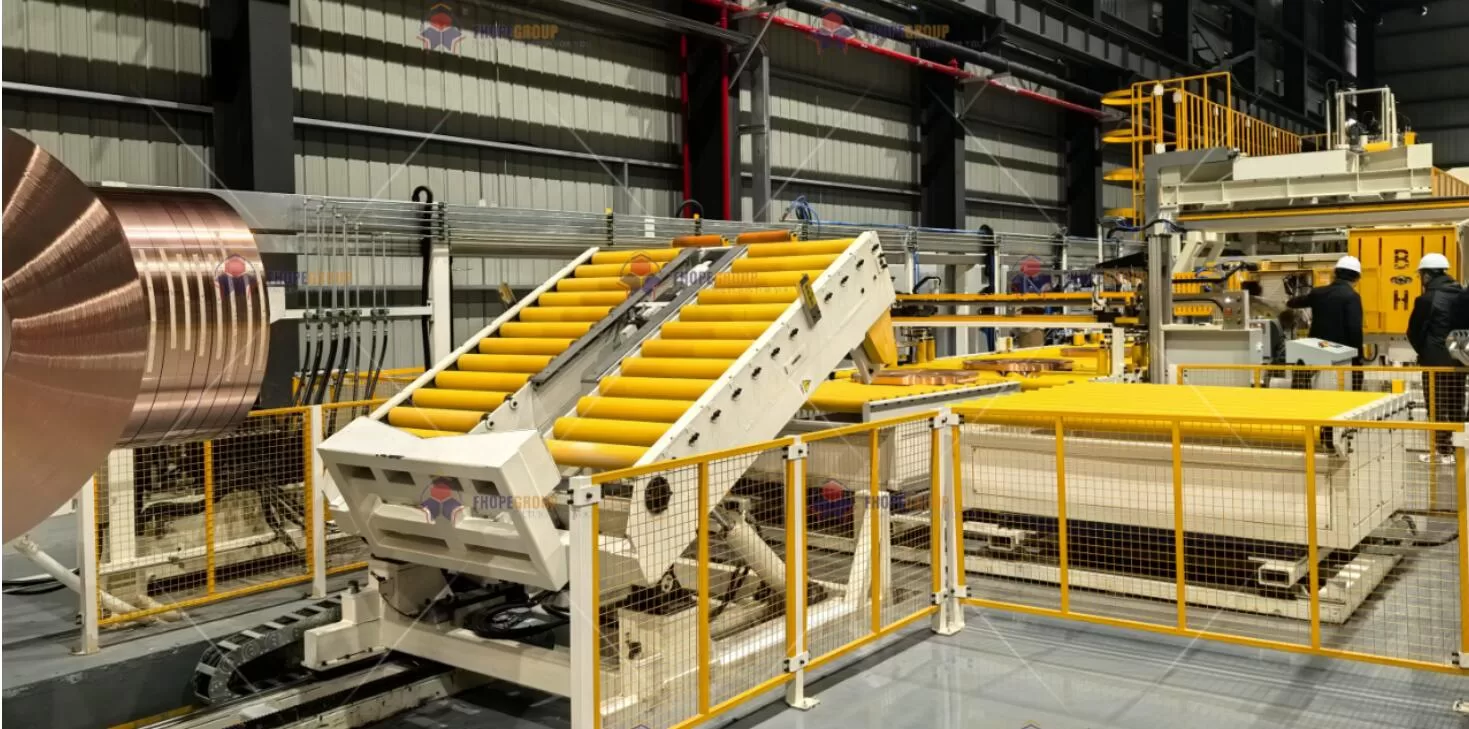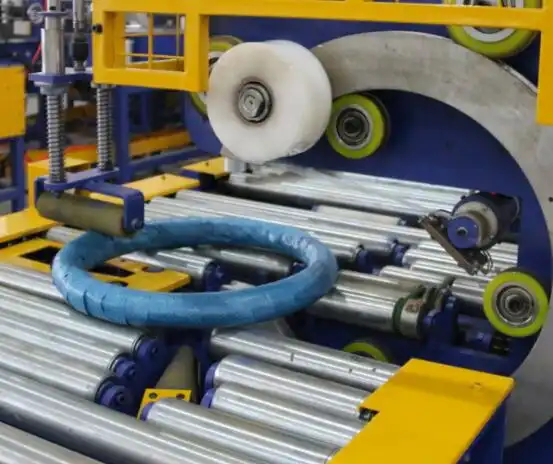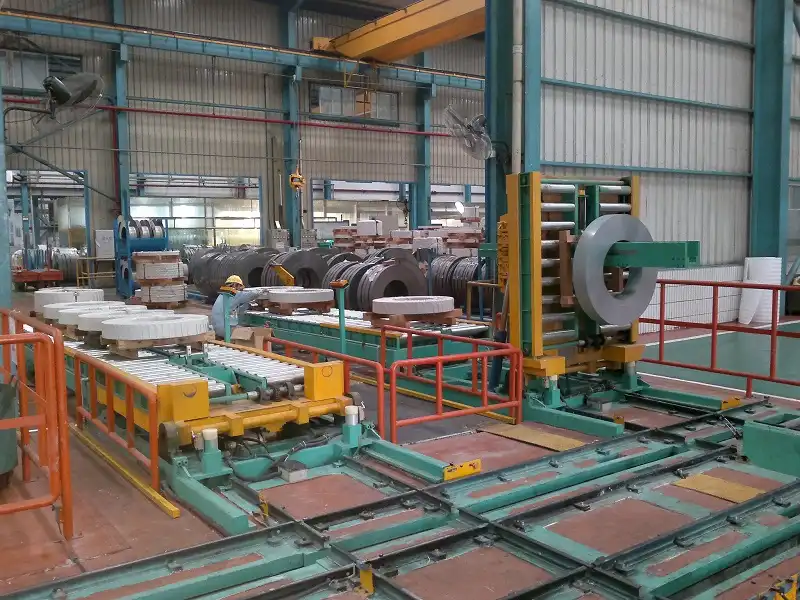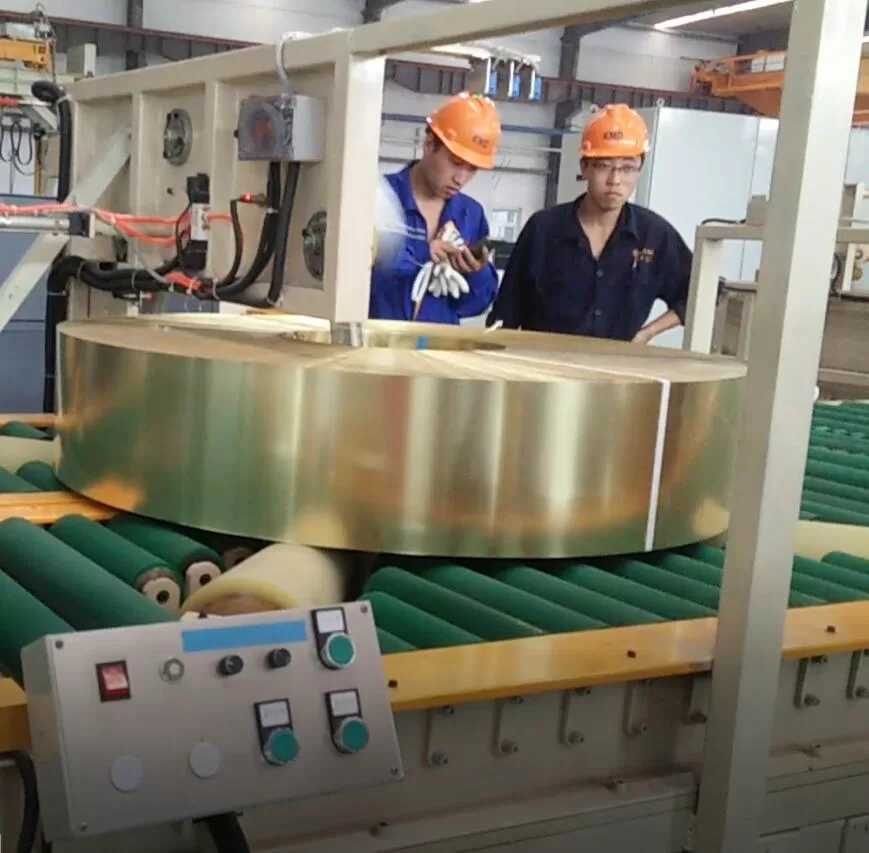You’ve worked hard to produce high-quality steel coils. You've negotiated a deal and are ready to ship a major order to a client in Thailand. This is a big win for your company. But then you get a call. The shipment is stuck at Laem Chabang port. The packaging failed, the coils are showing signs of rust from the humid sea air, and Thai customs are holding everything up. Now, you face the nightmare of rejected goods, expensive return shipping, and a damaged relationship with a valuable client. All your hard work and profit from the sale are at risk because of something that seemed like a final, simple step: packaging.
Your coil packing line is ready for Thailand's export standards only if it provides robust, multi-layered protection against extreme humidity and potential saltwater exposure. This means going beyond your standard domestic wrapping. You must use specific materials like VCI (Volatile Corrosion Inhibitor) film, waterproof outer layers, and secure strapping. Your labeling must also be precise, durable, and compliant with Thai customs regulations to avoid costly delays and rejections.

This might sound complicated, but it's completely manageable with the right knowledge and equipment. I've spent my entire career in the packing machine industry, first as an engineer and now as a factory owner. I’ve seen firsthand how a small investment in the right packing process can protect millions of dollars in product. Let's break down exactly what you need to consider to ensure your coils arrive in perfect condition, every time.
What Are Thailand's Specific Requirements for Steel Coil Packaging?
You believe your current packaging is strong enough for any journey. After all, it works for all your domestic clients. But exporting to a tropical country like Thailand is a different game. The long sea voyage, the high humidity, and the specific handling procedures at Thai ports can turn a minor packaging weakness into a major failure. If your coils arrive with even a hint of rust or damage, you risk the entire shipment being rejected. This isn't just about losing one order; it's about losing credibility in a competitive market.
Thailand requires steel coil packaging that offers superior protection against moisture, corrosion, and physical damage. The key is a multi-layer approach. This includes an inner layer of VCI (Volatile Corrosion Inhibitor) paper or film to chemically prevent rust. It also requires a tough, waterproof outer layer like reinforced kraft paper or woven plastic fabric. Finally, strong circumferential and eye-through strapping is essential to keep the coil and its protective layers tight and secure during rough handling at ports.

Dive Deeper: The Climate and Customs Challenge
When I help clients set up for new export markets, the first things we discuss are climate and local logistics. They are just as important as the steel's quality. Thailand presents a double challenge: a demanding tropical environment and specific port handling procedures. You must prepare for both.
Understanding the Thai Climate's Impact
Thailand's climate is tropical, with high temperatures and humidity levels that can exceed 80-90%, especially during the rainy season from May to October. This environment is a perfect breeding ground for corrosion.
- Condensation: During a long sea voyage, a steel coil goes through daily temperature cycles. The warm, humid air trapped inside the packaging can cool down at night, causing water to condense directly onto the steel surface. This is called "container rain," and it's a primary cause of rust on improperly packed coils.
- Saltwater Exposure: Even if the container is sealed, the air itself is filled with salt particles from the ocean. This saline moisture is highly corrosive and will attack any exposed steel.
Your packaging must create a complete barrier. It's not just about wrapping the coil; it's about creating a controlled micro-environment inside the package that actively fights moisture and corrosion. This is where materials like VCI film become non-negotiable for exports to this region.
Navigating Thai Ports and Handling
Your coil will likely arrive at a major port like Laem Chabang. These are busy, efficient ports, but handling can be rough. Forklifts, cranes, and temporary outdoor storage are common. Your packaging must be tough enough to withstand being lifted, stacked, and moved multiple times.
- Physical Integrity: Weak strapping can snap. A thin outer wrap can be punctured by a forklift. If the packaging is compromised, all the moisture protection becomes useless.
- Customs Inspection: Thai customs officials may inspect the cargo. They look for signs of damage and non-compliance. A rusty or poorly packaged coil is an immediate red flag that can lead to further inspections, delays, and potential rejection of the entire shipment.
Here is a simple comparison of a standard domestic packing solution versus one that is ready for export to Thailand.
| Feature | Standard Domestic Packaging | Thailand Export-Ready Packaging |
|---|---|---|
| Corrosion Protection | Basic stretch film or paper | VCI Paper/Film inner wrap + Desiccant packs |
| Waterproofing | May be water-resistant | Fully waterproof outer layer (e.g., PE-coated woven fabric) |
| Physical Protection | Standard stretch wrap, maybe cardboard | Reinforced edge protectors, thick outer wrap, strong strapping |
| Strapping | 2-4 circumferential straps (PP/PET) | Multiple circumferential & eye-through straps (PET/Steel) |
| Labeling | Simple domestic label | Durable, weatherproof international label with specific data |
Thinking about these details from the start changes your packaging from a simple cost to a strategic investment in quality assurance.
How Can Your Packing Material Choice Impact Thai Customs and Climate?
As a business owner, you are always watching costs. Choosing a cheaper packing material might seem like an easy way to save a few dollars per coil. But this is a classic example of false economy. When that inexpensive material fails under the stress of a 20-day sea journey and Thailand's humid climate, the consequences are severe. You'll face claims for corroded products, lose the trust of your customer, and the cost of replacing the damaged coil will erase any initial savings a hundred times over.
Your choice of packing materials is critical for a successful export to Thailand. Using the right materials, like VCI-infused films and waterproof outer wraps, is the best defense against the tropical climate and prevents rust, a major cause for customs rejection. Furthermore, using internationally compliant materials, such as heat-treated wood for pallets that meet ISPM 15 standards, is not optional—it is a mandatory requirement for clearing customs without issues.

Dive Deeper: Materials Science for Coil Protection
I’m an engineer by training, so I always look at the science behind why things work. For coil packaging, it’s about choosing materials that solve specific problems. It's not just about covering the coil; it's about creating a system of protection.
The Science of VCI Technology
Volatile Corrosion Inhibitors (VCI) are your most powerful tool against rust. This is not just a plastic film or a piece of paper. It's an active technology.
- How it Works: VCI materials are embedded with special chemical compounds. These compounds turn into a gas (they sublimate) inside the package. The gas molecules are drawn to the metal surface of your coil, where they form a very thin, invisible protective layer, just a few molecules thick. This layer stops the electrochemical reaction that causes rust. Even if some moisture gets in, the VCI shield prevents it from starting corrosion.
- VCI Paper vs. VCI Film:
- VCI Paper: Excellent for absorbing any initial condensation. It provides a good cushion and is easy to handle.
- VCI Stretch Film: Creates a tighter, more conforming seal. It's often combined with standard stretch film for strength. It's great for automated lines because it can be applied quickly and consistently.
For a market like Thailand, I almost always recommend a VCI product as the first layer that touches the steel.
Building a Strong Physical Barrier
After the VCI layer, you need to build a tough outer shell. This shell has two jobs: keep water out and resist physical damage.
| Material | Role | Pros in Tropical Climate | Cons / Things to Watch For |
|---|---|---|---|
| HDPE Woven Fabric | Tough, waterproof outer wrap | Excellent puncture and tear resistance. Fully waterproof. | Seams must be sealed properly to be effective. |
| PET Strapping | Securing the package | High strength. Does not rust. Stays tight. | Requires proper tensioning tools to be effective. |
| Steel Strapping | Heavy-duty securing | Highest tensile strength for very heavy coils. | Can rust if not galvanized; can damage coil if over-tightened. |
| Edge Protectors | Protecting corners from strap damage | Prevents straps from cutting into the product/packaging. | Must be made of durable material (e.g., pressed board). |
Don't Forget ISPM 15
This is a simple point, but it sinks many shipments. If your coil is on a wooden pallet or has any wooden bracing, that wood must be treated and stamped according to ISPM 15 standards. This standard ensures no invasive pests are transported in wood packaging. Thai customs officials are very strict about this. An incorrect or missing stamp means your shipment will be fumigated at your expense or even denied entry. It's a small detail with huge consequences.
Does Your Current Packing Line Automation Meet Throughput Demands for Thai Exports?
Your packing team is reliable and they handle your current production volume without issues. But now, you have a contract to ship 500 coils to Thailand every month. Suddenly, your manual packing area becomes a major bottleneck. Your team is working overtime, but the pace is slow. The quality of the wrap is inconsistent from the first coil of the day to the last. You're starting to worry about missing shipping deadlines, which can lead to financial penalties and upset your new client. The pressure is on, and your current process is not built for this kind of sustained demand.
Your current packing line, if mostly manual, is unlikely to meet the speed and consistency required for large-scale Thai exports. Upgrading to a semi-automatic or fully automated packing line is necessary to meet throughput demands. Automation ensures every coil is wrapped to the same high standard, significantly increases packing speed to prevent bottlenecks, and reduces the reliance on manual labor, ultimately lowering long-term operational costs.

Dive Deeper: The Case for Automation
As a factory owner, I analyze every investment for its return. Automation in the packing line isn't a luxury; for export operations, it's a necessity. It solves three key problems: speed, quality, and cost. Let’s look at how this applies to a CEO or plant manager who needs to justify the investment.
Bottleneck Analysis: A Tale of Two Lines
Imagine the journey of a single coil through the packing process.
Manual Packing Line:
- Staging: A forklift brings the coil to the packing area. (2-3 minutes)
- Wrapping: Two workers manually walk around the coil with rolls of VCI paper and stretch film. (10-15 minutes)
- Strapping: They use a manual tensioner and sealer for PET straps. (5-7 minutes)
- Labeling: Someone prints a label and manually applies it. (1-2 minutes)
- Total Time: 18-27 minutes per coil.
- Consistency: Depends heavily on the workers' skill and fatigue. The last coil of a shift is never packed as well as the first.
Automated Packing Line:
- Staging: An automated conveyor moves the coil into the packing station. (1 minute)
- Wrapping: A vertical wrapping machine applies VCI film and stretch film with precise overlap and tension. (2-3 minutes)
- Strapping: An automatic strapping machine applies and seals the straps. (1-2 minutes)
- Labeling: An integrated printer-applicator creates and applies the label. (10 seconds)
- Total Time: 4-6 minutes per coil.
- Consistency: Perfect. Every coil is packed to the exact same specification.
| Process Step | Manual Line (Time/Coil) | Automated Line (Time/Coil) | Key Advantage of Automation |
|---|---|---|---|
| Coil Handling | 2-3 mins | 1 min | Reduced forklift traffic, safer |
| Wrapping | 10-15 mins | 2-3 mins | Speed, consistent tension & overlap |
| Strapping | 5-7 mins | 1-2 mins | Speed, perfect strap tension |
| Total | ~20 mins | ~5 mins | 4x Throughput Increase |
Calculating the Return on Investment (ROI)
A leader like you needs to see the numbers. The ROI for an automated line comes from several areas:
- Labor Savings: You can re-assign packing labor to more value-added tasks. If two workers are no longer needed for packing, that's a direct salary saving.
- Increased Throughput: If you can pack 4 times faster, you eliminate the packing bottleneck. This means your entire production line can run at its optimal speed. You can take on more orders without needing more space or people.
- Reduced Material Waste: An automated wrapper uses the exact amount of film needed, with the right amount of stretch. Manual wrapping often leads to excessive material use "just to be safe." This can add up to a 10-20% material saving.
- Elimination of Damage Costs: Consistent, high-quality packing means fewer rejected shipments and damage claims. This is a direct saving to your bottom line.
When I established my own factory, I faced this exact decision. The initial cost for an automated line was significant. But when I calculated the payback period based on labor, material savings, and increased capacity, the investment made perfect sense. We saw a full return in under two years, and it allowed us to grow our business much faster than our competitors.
Is Your Data and Labeling System Compliant with Thai Regulations?
Your team has done a fantastic job. The coil is perfectly protected with VCI film, a waterproof wrap, and strong PET straps. It looks indestructible. But then, as the final step, a worker prints a standard domestic label on plain paper and tapes it to the side. During the long journey, the label gets wet and the ink runs. At the port, it gets torn. When it arrives at Thai customs, the label is unreadable. The officials have no way to verify the contents, weight, or origin. Your perfectly packed coil is now an anonymous, suspicious package, leading to indefinite delays, manual inspections, and frustrated calls from your client.
To be compliant, your labeling system must produce clear, durable, and accurate labels that can survive the entire shipping journey. These labels must contain specific information required by Thai customs, including HS codes, weights, and handling symbols, often in both English and Thai. Using a system that integrates directly with your production data and prints on weatherproof materials is the only way to guarantee compliance and avoid these easily preventable delays.

Dive Deeper: Data is the Final Layer of Protection
The physical packaging protects the coil itself. The data on the label protects your shipment's journey through the complex world of international logistics. A failure in data is just as critical as a failure in the physical wrap.
Essential Information for a Thai-Compliant Label
Think of the label as your coil's passport. It needs to contain all the right information to be allowed entry. While specific requirements can vary based on the client, a standard international shipping label for Thailand should include:
- Shipper and Consignee: Full name and address of your company and your client.
- Country of Origin: Clearly stated.
- Port of Loading & Port of Discharge: e.g., Shanghai to Laem Chabang.
- Product Description: e.g., "Cold Rolled Steel Coils".
- HS Code (Harmonized System): The international code for your product. This is critical for customs duties.
- Gross Weight & Net Weight: Must be 100% accurate. Discrepancies are a major red flag for customs.
- Coil Dimensions: Diameter, width.
- Unique Coil ID / Heat Number: For traceability back to your production records.
- International Handling Symbols: Icons for "Keep Dry," "Use No Hooks," "Fragile," etc.
Accuracy is everything. A simple typo in the weight or HS code can lead to customs fines and delays as officials try to sort out the mistake.
Label Durability and Placement
A paper label will not survive. You must invest in a labeling solution designed for industrial environments and international shipping.
- Material: Use synthetic labels, typically made of polyester (PET) or polypropylene (PP). They are waterproof, tear-proof, and resistant to oil and chemicals.
- Printing: Thermal transfer printing is the industry standard. It uses a ribbon to fuse the ink to the label material, creating a permanent, smudge-proof image that won't fade in sunlight or run when wet. This is far superior to standard inkjet or laser printing on paper.
- Placement: The label should be placed in a protected but visible location. For eye-to-sky coils, a good spot is on the outer wrap of the sidewall. For eye-to-wall coils, it should be on the top surface. A second label is often a good idea as a backup.
Integrating Labeling with Your Digital Transformation
For a forward-thinking leader focused on digitalization, an integrated labeling system is a key component. This moves you from manual data entry to a seamless, error-proof process.
| Feature | Manual Labeling System | Integrated (MES/ERP) Labeling System |
|---|---|---|
| Data Entry | A worker types data from a sheet into a PC. | Data is pulled automatically from the MES system. |
| Error Potential | High (typos, wrong coil ID, incorrect weight). | Virtually zero. The data is direct from the source. |
| Speed | Slow. Worker must find data, type, print. | Instant. The label is printed as the coil finishes packing. |
| Traceability | Difficult. Relies on paper records. | Complete. The label is linked to the coil's full production history. |
An integrated system ensures that the data on the label perfectly matches the data in your production system. This not only satisfies customs but also provides immense value for your own quality control and for your client. It’s a crucial step in achieving the total production visibility you are aiming for.
My Take as an Engineer and Founder
I’ve read about leaders like you, Javier. You started in the trenches of the steel industry and built a major operation from the ground up. You understand the machinery, the market cycles, and the constant pressure on costs. You're not just buying a machine; you're investing in stability, efficiency, and future growth. Your challenges—aging equipment, energy costs, digitalization—are exactly what we at SHJLPACK focus on solving.
I remember the struggle with older equipment in the factories where I worked. A 15-year-old packing line is a constant source of worry. The downtime kills your throughput, and unpredictable failures make scheduling impossible. Your goal of 95% uptime is ambitious but achievable. A modern, modular packing line isn't just a replacement; it's an operational upgrade. We design our systems with high-quality components and for predictive maintenance. Sensors can monitor motor health and material tension, allowing you to service parts before they fail. This is how you get to 95% availability.
You're also looking to cut operating costs by 8% and energy use by 10%. A well-designed packing line is a key contributor. Our machines use high-efficiency motors that draw less power. The precision of an automated wrapper reduces film and paper waste significantly compared to manual methods. This isn't about one big change; it's about dozens of smart engineering choices that add up to real savings on your balance sheet.
Most importantly, you are driving a digital transformation with MES and IoT. Our machines are built for this new reality. They are not isolated pieces of metal; they are intelligent data nodes on your network. We provide the PLC logic and communication protocols (like OPC-UA or Profinet) to connect seamlessly with your factory's MES or SCADA system. When a coil is wrapped, its ID, weight, and packaging status are automatically sent to your central system. This provides the comprehensive production visibility you're looking for and makes generating compliant, error-free shipping labels automatic.
You need a strategic partner, not just a supplier. This philosophy is the reason I founded SHJLPACK. After achieving my own success, my mission became helping others in this industry thrive. We don't just send you a quote. We engage in a deep consultation, perform a rigorous feasibility analysis—the kind you value—and work with you from design and installation to training and long-term support. Our slogan, "TOTAL SOLUTION FOR WRAPPING MACHINE," is our promise. We are here to be your expert partner for the entire finishing and logistics end of your production line.
Conclusion
Preparing your coil packing for Thailand is not just about compliance. It’s a strategic move to protect your product, reputation, and profits in a key international market.




